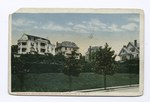Serpentine Ridge Nature Preserve
The Serpentine Ridge Nature Preserve is a 40 acres woodland in the North Shore of Staten Island between Howard Avenue at the top of the ridge and Van Duzer Street at the bottom of the hill. The Serpentine Ridge plays an important part in Staten Island's ecosystem and biodiversity and maintains significant geological features. The Serpentine Ridge is a steep terrain on the east shore of the island within the Grymes Hill and Silver Lake neighborhoods of Staten Island. The area is notable for its variety of ecosystems including wooded hillsides, glacial sinkholes, and bare serpentine rock. The area is part of Staten Island's Special Hillsides Preservation District. The district was established to preserve the hilly terrain and unique natural features of the region, by reducing hillside erosion, landslides, and excessive storm-water runoff. Most of its land remains in a natural state, thus the area is covered with native vegetation. The Serpentine Art and Nature Commons owns approximately 11.5 acres of land within the area and acts as an environmental steward to the entire area.
Excerpt from the Wikipedia article Serpentine Ridge Nature Preserve (License: CC BY-SA 3.0, Authors).Serpentine Ridge Nature Preserve
Shelterview Drive, New York Staten Island
Geographical coordinates (GPS) Address Nearby Places Show on map
Geographical coordinates (GPS)
| Latitude | Longitude |
|---|---|
| N 40.623944444444 ° | E -74.08675 ° |
Address
Shelterview Drive 101
10304 New York, Staten Island
New York, United States
Open on Google Maps





